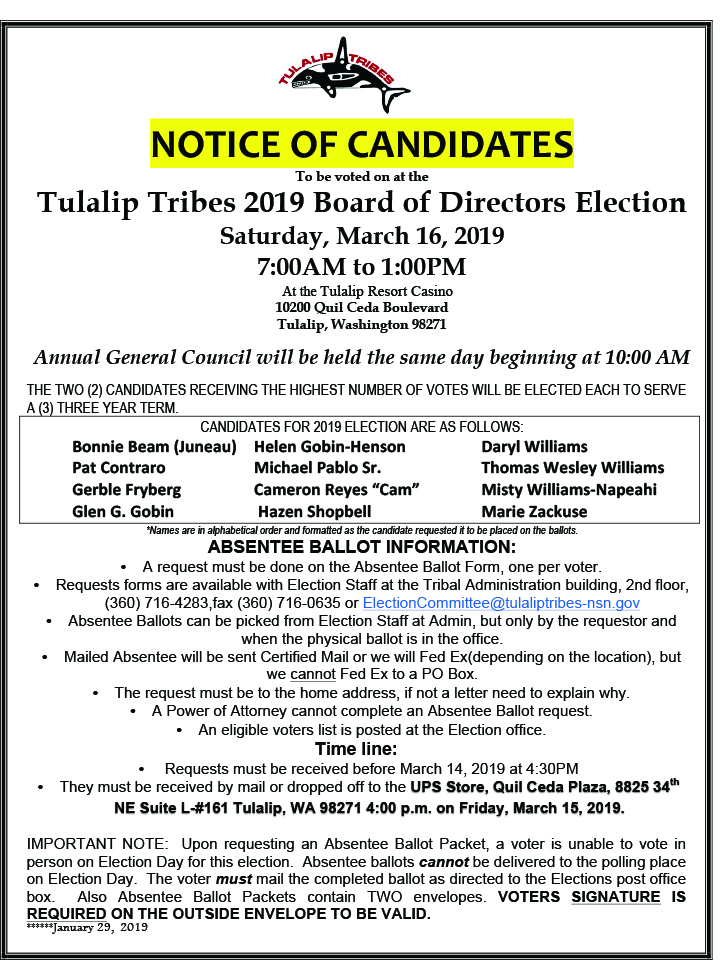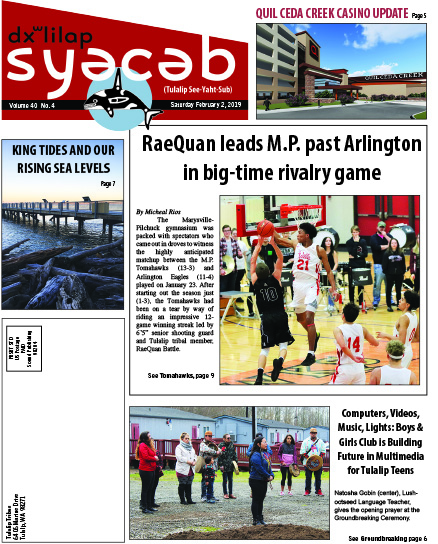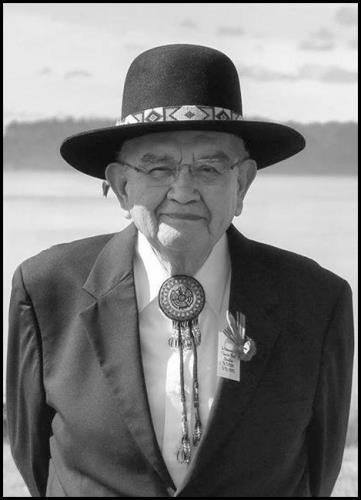 June 28, 1931 – January 30, 2019 Raymond Robert Sheldon Sr., 87, passed away Wednesday, January 30, 2019. An Interfaith service will be held on Tuesday, February 5, 2019 at 6:00 p.m. at the Greg Williams Court with a light dinner at 5:00 p.m. Funeral Services will be held Wednesday, February 6, 2019 at 10:00 a.m. at the Greg Williams Court with burial to follow at Mission Beach Cemetery.
June 28, 1931 – January 30, 2019 Raymond Robert Sheldon Sr., 87, passed away Wednesday, January 30, 2019. An Interfaith service will be held on Tuesday, February 5, 2019 at 6:00 p.m. at the Greg Williams Court with a light dinner at 5:00 p.m. Funeral Services will be held Wednesday, February 6, 2019 at 10:00 a.m. at the Greg Williams Court with burial to follow at Mission Beach Cemetery.
Native American Student Art Festival, April 18
Notice of Candidates, Tulalip Tribes 2019 Board of Directors Election
Chief of Police letter to the Tulalip Community,
Chief of Police letter to the Tulalip Community,
I am reaching out to the Tulalip community for your help, drugs are causing great harm and impact on the lives of the people. I have witnessed and also heard the many personal experiences of pain and tragedy inflicted upon the Tulalip community by drug dealers who intentionally prey upon those afflicted with addictions. These drug dealers traffic into the Reservation dangerous and deadly drugs causing devastating and tragic outcomes to individuals, families, and our community.
The opiate drug epidemic is a national crisis and our community is not exempt. This problem requires the coming together of the community, police, and other service providers to effectively make a difference. Let my message be clear, for drug dealers, profiting off the pain and misery of others, the Tulalip Police Department will relentlessly investigate and pursue criminal charges. For those afflicted in the vice of addiction, we offer our support and referral to Tribal service providers and other resources for help.
Today, January 31, 2019, the Tulalip Police Department is out in the Community conducting a neighborhood outreach effort in the Quil Neighborhoods on 27thAve NE. This is part of the Tulalip Police Department’s commitment to working with the Community to address illicit drug dealing, and to assist individual by providing services resource information to those who may be afflicted with chemical dependencies.
Uniformed police officers will be going door to door introducing themselves to members of the community. Officers will provide information and offer any assistance to help improve the livability and safety of the neighborhoods. The Police Department also is planning to hold Neighborhood Policing Meetings to help facilitate improved communications and trust. I welcome the community’s input and concerns, my goal is to work collaboratively in partnership to solve problems.
Community members and neighborhood groups interested in scheduling in a meeting with the Police Department are asked to call Cmdr. Paul Arroyos at 360 716-5924.
To make an anonymous Narcotics Complaint please call the Tulalip Drug Task Force Tip Line at 360 716-5990, or call Drug Task Force Cmdr. Jim Williams at 360 716-5927.
Sincerely, Chris Sutter
Spring 2019 Free CERT Basic Training, May 1-3
Renovated third floor of King Street Station opens as a dynamic art space with inaugural exhibition offering collective portrait of Native America
yəhaw̓, on view at ARTS at King Street Station March 23 to Aug. 3, 2019,
highlights contemporary Indigenous creatives
Opening celebration Saturday, March 23, 2019, noon – 7 p.m.
Admission is free
SEATTLE, Jan. 31, 2019 – An exciting new arts and cultural hub opens in Seattle on March 23, 2019, when ARTS at King Street Station debuts with the dynamic exhibition yəhaw̓, which presents some 200 works showcasing contemporary Indigenous creatives.
ARTS at King Street Station was conceived as an innovative, community-powered arts and cultural hub that encompasses art, artists and culture through the lens of racial equity. The exhibition space provides a holistic view of art and the people who make, consume and live it. Informed by an extensive community input process, ARTS at King Street Station was conceived to reflect the creativity and talents of people that continue to create the fabric of Seattle.
On view through Aug. 3, 2019, the inaugural exhibition yəhaw̓ (pronounced yee-hout) will open ARTS at King Street Station, an historic space now dedicated to increasing opportunities for communities of color to present work. “It is fitting that we inaugurate the space with a nod to the incredible artistry of the Coast Salish peoples, on whose land the City of Seattle is built,” says Randy Engstrom, director of the Office of Arts & Culture (ARTS).
The exhibition title yəhaw̓ is drawn from the Coast Salish story that tells of Native people from all tribes uniting around a common cause and lifting up the sky together. Appropriately, yəhaw̓ reflects a nuanced, inclusive narrative that firmly establishes Native creatives as belonging in the here and now. Prior to the culminating exhibition that opens March 23, yəhaw̓ has encompassed satellite installations throughout the region, performances, artist-in-residence, a publication, art markets, in an expansive, yearlong project.
All Indigenous creatives living in the Puget Sound region were invited to participate in the yəhaw̓ project, and all who applied had the opportunity to have their work represented in the programming. Conceived and curated by Tracy Rector (Choctaw/Seminole), Asia Tail (Cherokee Nation) and Satpreet Kahlon, the resulting yəhaw̓ project features the work of some 200 creators of all backgrounds and experience, in disciplines including sculpture, photography, design, printmaking, woodworking, film, metalwork, glass and textiles.
Several artists were commissioned for site-specific artworks, including Chai Adera, Natalie Ball, Demian DinéYazhi´, Malynn Foster, Sara Siestreem, Adam Sings in the Timber, Timothy White Eagle, Christine Babic and more. In addition, 10 emerging artists, such as Priscilla Dobler, Randi Purser and Asa Wright were selected to participate in a mentorship program, receiving artistic guidance from established Native artists.
________________________________________________________________
The new ARTS at King Street Station space responds directly to feedback from community focus groups with an emphasis on people of color. Located on the third floor of the 123-year-old train station, the 17,500 square-foot cultural hub was designed by Schacht Aslani to provide flexible, co-use areas for community gathering in addition to professional office and gallery space. The design contains a large multi-disciplinary arts presentation gallery, a public “living room” lobby, a multi-use conference room for large meetings and public presentations, an artist-in-residence space, offices and meeting rooms. In the presentation space kinetic gallery walls designed by Olson Kundig enable community and artists to reconfigure the displays as needed for changing exhibitions and events. Throughout, new architectural interventions emphasize transparency, highlighting and revealing historic elements of the original building such as the historic masonry and steel structural system, ornamental stairway and original terrazzo floor. ARTS at King Street Station is located at 303 S. Jackson St., third floor, Seattle, WA 98104. Open Tuesday – Saturday,
10 am – 6 pm, and First Thursdays, 10 am – 8 pm. Admission is free.
Quil Ceda Creek Casino update
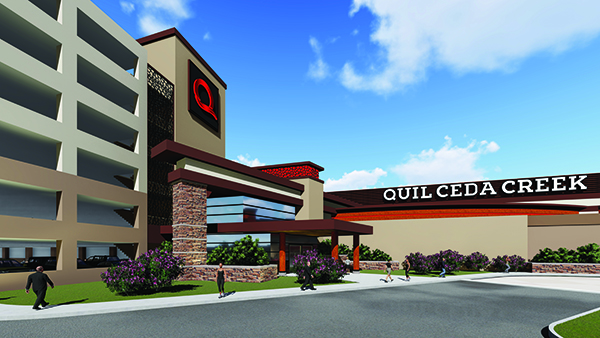
By Micheal Rios, Tulalip News
After months of delay, construction is again underway on the $125 million casino and parking garage that will replace the aging Quil Ceda Creek Casino (locally referred to as ‘the Q’). The lengthy pause in construction was primarily due to the Tulalip Tribes undergoing a strenuous process to replace the original general contractor, Tribal Designs/Wright Hotel Development.
“Due to a lawsuit brought against the Tulalip Tribes by Tribal Designs/Wright Hotel Development we have not been able to comment in any detail on the reasons for the termination of the agreement with Tribal Designs/Wright Hotel Development,” stated Chairwoman Marie Zackuse. “We are currently in mediation and hope to find a mutually acceptable solution between the Tulalip Tribes and Tribal Designs/Wright Hotel Development.”
Andersen Construction is the new design-build contractor. Presently, Andersen Construction is starting with site work that includes soil improvement work and grading, installing concrete footings, and will soon start on the underground plumbing and electrical.
The multi-million dollar project will relocate the Q facility from its current location to a fifteen-acre property across the street on Northeast 33rd. Replacing the Q Casino was based on a number of factors, the most prominent being a stagnant revenue stream that is unable to grow due to logistical and structural challenges posed by the current facility. Also, with an ever growing population, it is critical to generate more revenue in order to meet the costs associated with more and more Tulalip citizens.
“We’re replacing [the existing Q] because it is bursting at the seams,” explained Les Parks, Board of Director Treasurer. “The revenue cannot grow anymore, they are using every square foot they can, and our customers are screaming for more machines and a hotel to stay at. This new journey is going to get us there.”
The project cost is “rolled into the syndicated loan that includes the new Quil Ceda Creek Casino, its parking structure, and the future Gathering Hall,” continued Les. “This is the same amount that was approved by General Council three years ago. Without increasing the loan amount, we were able to add in the hotel by extending the deferred payment process, which is typical of loans we do, to put more money towards actual construction.”

The new Q Casino will span 126,000 square feet and allow for 1,500 gaming machines, a lofty increase from the current 1,000 operating at the existing QCC facility. The 500 extra slot machines will bring in millions of additional gaming revenue annually.
Besides the increase of slot machines, there will be expanded table games, an innovative dining hall experience with multiple cooked-to-order food venues, an upgraded entertainment venue, and a state of the art smoke elimination system included in the new locals casino.
Current parking at the Quil Ceda Creek Casino has always been a nuisance for regulars. The new Q will solve that issue by having a parking garage that holds 1,068 stalls, plus surface parking for 684 vehicles. That’s total capacity for 700+ more vehicles than currently available.
The design schematic leaves the option open for the opportunity to build on a hotel to complete a casino resort destination stay, like the Tulalip Resort Casino.
“We have to maintain our competitive advantage by staying up to date with what’s going on in the gaming industry,” said Vice-Chairwoman Teri Gobin. “The Emerald Queen will be opening their new facility soon, Ilani recently had a renovation, and Snoqualmie is looking to add a second tower. That’s our competition and they all have or are going to build additional hotels.
“We all know the Tulalip Resort sells out every weekend, and that overflow of guests who can’t get a room with us end up staying in Marysville. That is lost revenue that we could keep if we add a hotel to the Q,” continued Teri. “Having a hotel is very important in order to keep our customer base while providing opportunity for many new guests to experience Tulalip.”
Potentially, an add-on hotel would feature 150 guest rooms, special event space and meeting facilities, while having recreation space that includes a pool, spa and exercise room. The Tribe is also investing in street improvements to enhance ease of access to the new casino.
“We anticipate this property remaining very popular with our local customers and will also attract new gamers,” said Chairwoman Zackuse.
The new Quil Ceda Creek Casino and parking garage is expected to open February 2021.
February 2, 2019 syəcəb
Click here to download the February 2, 2019 issue of the syəcəb: SYS 02022019
King tides and the impacts of rising sea levels
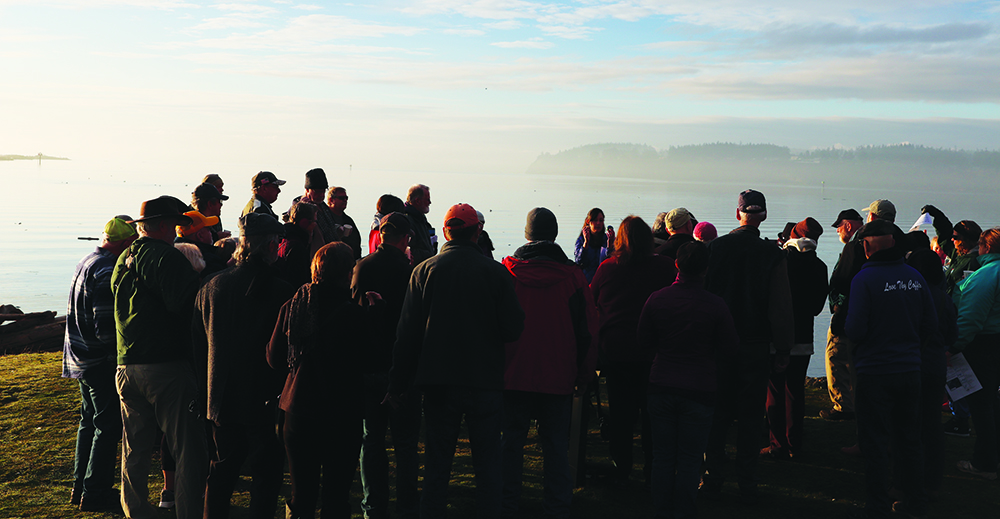
By Kalvin Valdillez; photos by Kalvin Valdillez and Ben Lubbers
Bright and early on the morning of January 25, a gathering of about thirty people met at Flintstone Park in Oak Harbor. Similar to Tulalip Bay, the waters of the Salish Sea travel into the inlet of Whidbey Island, providing a scenic view for the citizens of Island County. This morning in particular was gorgeous. While the sun emerged into the sky, fog slowly ascended from the water that was now approaching the paved boardwalk of the park. This was the event the locals came to witness, a king tide.
On the night of January 20, you may have caught a glimpse of the super blood wolf moon as the sun, earth and moon aligned perfectly. This rare lunar eclipse is also known as syzygy and causes a stronger gravitational pull and therefore, higher tides. At an estimated thirteen feet, the tide was highest at 8:28 a.m. in Oak Harbor that Friday morning. The long stretch of sand, rocks and driftwood that makes up the beach of Flintstone Park appeared to have vanished as large waves splashed against the coast.
“King tide is not a scientific term, it simply means higher than our normal everyday tides,” explained Bridget Trosin, of Washington Sea Grant, to the crowd. “In this area, we get king tides usually in November, December, January and February. One of the situations where we get a king tide is at a perigee tide. Basically that is when we orbit the sun and as the moon passes in that close section we get higher than high tides. As the moon is hugging the earth in its orbit, it’s bulging out our ocean waters.
“The other situation is when we have a nice alignment of the sun, earth and moon, that’s where we see a nice king tide from the pull from the sun and the pull from the moon as they’re compounding upon each other. And another event happens only on January 2. That’s as Earth is orbiting around the sun, we’re closer and that creates pull from the sun and makes our tides a little larger than normal. Any one of those situations can happen at the same time and each one gives the tide a directional pull.”
Now that the Oak Harborites acquired both a better understanding as well as a live visual of a king tide, Bridget requested that each member of the group download an app to their phones called MyCoast. The purpose of the app is to measure king tides at local shores by using user submitted photos. She then stressed that king tides are an important occurrence and the need to monitor them is crucial because they give us a glimpse into the future of what normal, or perhaps even low tides, might look like in a few decades due to sea-level rise.
Rising sea-level is a complex topic that will in time impact the entire planet. Many major cities across the world will experience severe flooding and in some extreme cases will be underwater completely. Because sea-level rise is so dynamic and there are several factors in play, it’s hard to determine exactly when specific areas will begin to see major impacts. However, the general consensus appears to be that sea-level will continue to rise at about its current rate until the middle of this century and then will actually accelerate at even a faster pace after that.
So what causes sea-level rise exactly and why should you be concerned? Since the Industrial Revolution in the 1800’s, the Earth has been heating up due to the burning of fossil fuels and the production of greenhouse gases. As the planet traps those emissions in its atmosphere, the warmer Earth gets. And as a direct result of global warming, the amount of water in the ocean is increasing because as water heats, it expands. Another large contributing factor to sea-level rise is the melting ice caps and ice sheets happening in both Greenland and Antarctica.
“Sea-level has risen eight or nine inches in the last hundred years and it’s accelerating,” says Phillip North, Tulalip Natural Resources Conservation Scientist. “Since global warming is happening faster than we expected, that means the water is getting warmer faster and expanding. We’re getting more sea-level rise than expected. Plus, the warmer ocean is melting the ice faster. Greenland is melting faster, Antarctica is melting faster, all the continental glaciers; everything’s melting faster than we expected. We’ll see a pretty steady progression up until the middle of the century and then it will start to speed up. It does seem that anytime anyone has ever said something like that, it’s happened sooner than expected and more than expected. We are already seeing it.”
Shortly after the King Tides event in Oak Harbor, and we’re talking merely a few hours, reports from major news sources were released. Alerts from the New York Times, BBC News and CNN began to pop-up onto people’s smartphones claiming that Greenland’s ice caps are indeed melting at an even much faster pace than predicted by scientists, environmentalist and conservationists.
The news was shocking to say the least and sent social media into a bit of a frenzy. The reports show ice caps in Greenland’s southwest region have been melting at least four times faster in the past decade than they have over previous centuries. Due to the combination of global warming paired with oscillation, a weather phenomenon that affects air temperature, Greenland’s ice caps are not only breaking off into large icebergs, which over time melts into the ocean, but are also beginning to thaw at the top of the glaciers which is causing ‘rivers’ of meltwater to pour into the ocean, and is subsequently melting more ice as it travels down the glaciers. Cities along the east coast of the United States will be the first to be affected and will see significant sea-level rise and are also now susceptible to more hurricanes.
Northwest tribal nations have been anticipating a rise in water for at least a few generations now. As coastal communities, Salish tribes are one the first to feel and witness the effects of sea-level rise. As you may recall, the Quinault tribe is currently in the early process of relocating both of their entire villages of Taholah and Queets because rising sea-level and high tides have already begun to flood the communities.
As sea-level rises, it has the potential to change entire landscapes. In a report released in the summer of 2018, the Projected Sea Level Rise for Washington State, evidence shows that because of the Juan de Fuca tectonic plate, many Puget Sound communities are currently sinking while Neah Bay’s land is actually rising.
In addition to inundation and landform change, another huge impact sea-level rise will have on tribal communities is habitat loss, reducing marshes, mudflats and intertidal habitats. Habitat loss can cause significant changes to the food chain and as Phillip explains, this happens due to the erosion of coastlines.
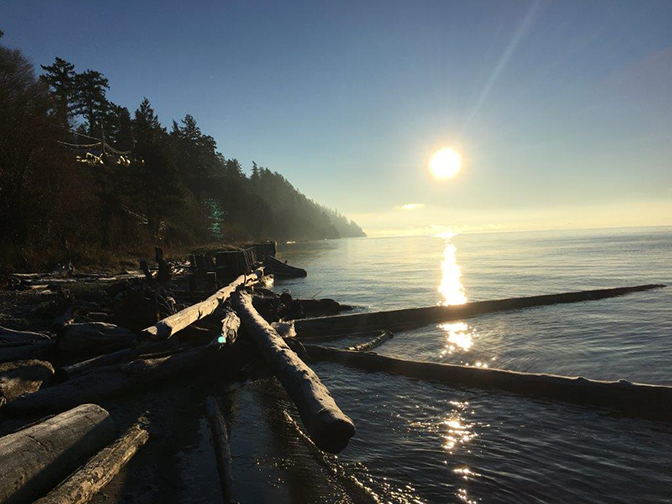
“One thing we are studying in Tulalip is our outer coast,” he states. “Because as sea-level rises, a couple things will happen. One, the water will be at base more often and it’s the water at the base of the bluff that erodes the bluff more than anything else. But also because it will be higher than the storms that are coming in. When storms come in, you have the distance over open water that the winds are blowing, the greater the distance the bigger the waves. But also the deeper the water, the less those waves are dragging on the bottom of the ocean floor and losing energy. So the deeper the water is, those bigger waves will come further in and hit the bluff more often. So you end up with faster erosion. As it erodes faster, that means that all the material is coming down faster.
“That material is what makes up the intertidal habitat. So how will the system deal with that, that’s another important question. That’s where all the clam beds, juvenile crab are and that’s where all the juvenile salmon and forage fish hang out. The dynamics of the energy of the waves on the beach sorts all that material, so you end up with patches of fine sand and gravel. All of those different patches are different type of habitat, so if you change the energy on the beach, those things all change. Those changes of energy change the habitat. Most of the detrital food chain are not eating the grass and seaweed directly but they’re eating it when it dies and starts to decay – that’s the base of a food chain. The way the detrital material gets distributed changes the habitat for juvenile crab, juvenile salmon, forage fish and all those organisms that live in those areas.”
Unfortunately, sea-level rise is inevitable. Yes, you read that correctly. In time, which is proving to be closer than we thought, all of the ice caps will melt and the world’s water to land ration will increase. How much it will increase and when is still yet to be determined but if the recent news of Greenland’s ice caps are any indication, scientists are predicting by the year 2100, cities around the globe can see anywhere from three to ten feet of sea-level rise. And although the east coast will probably see the effects on a larger scale, the entire west coast along the Cascadia subduction zone could be pushed back, making many current coastal cities uninhabitable. Researchers are hoping communities can look at these statistics and estimations to plan for relocation if need be and to prepare for a series of natural disasters such as extreme floods, storms and hurricanes that could result from sea-level rise.
“Get involved in your communities,” urges Bridget. “Let your planning commissioner know that this is something that you are concerned about, this is something we need to get on board with and make a priority. This is something that is extremely important to the resilience of your community.”
Please visit www.WAcoastalnetwork.com to view the most recent reports and projections of sea-level rise in Washington. And be sure to check out the National Oceanic and Atmospheric Administration Sea-Level Rise Viewer at www.coast.noaa.gov/slr/ to see how sea-level rise, of up to ten feet, can impact your communities, as well as for additional information.
RaeQuan leads M.P. past Arlington in big-time rivalry game
By Micheal Rios, Tulalip News
The Marysville-Pilchuck gymnasium was packed with spectators who came out in droves to witness the highly anticipated matchup between the M.P. Tomahawks (13-3) and Arlington Eagles (11-4) played on January 23. After starting out the season just (1-3), the Tomahawks had been on a tear by way of riding an impressive 12-game winning streak led by 6’5” senior shooting guard and Tulalip tribal member, RaeQuan Battle.
RaeQuan is joined by fellow tribal members Alec Jones and T.J. Severn, both juniors on the much hyped M.P. squad. Arlington has a tribal member on its team, too, in freshman Quintin Yon-Wagner. The Tulalip ties gave even more significance to the regular season game, as many members of their families turned out to watch the athletic contest. Fortunately, everyone in attendance was treated to a very entertaining and competitive game that went down to the wire.
In the 1st quarter, Marysville-Pilchuck jumped out to an early 12-1 lead. Thanks in part to an engaged RaeQuan getting buckets from the perimeter, inside, and at the free-throw line his Tomahawks led 14-4 after the opening period. Alec, coming off the bench, provided instant defense and on-ball pressure for the Tomahawks’ backcourt.
After enjoying a 28-18 halftime lead, M.P. saw their advantage disappear when Arlington caught fire from the perimeter and made back-to-back 3-pointers. Things took a bad turn midway through the 3rd quarter when RaeQuan took an accidental elbow to the head. The contact opened up a cut along his eye and forced him to the M.P. bench while receiving medical treatment.
With their best player on the bench, the Tomahawks’ offense struggled. Meanwhile, Arlington hit several consecutive jumpers to give the Eagles their first lead of the ball game. Alec scored a transition layup for the Tomahawks, tying the game at 36-36, but at the end of the 3rd quarter M.P. trailed Arlington 36-38.
The 4th quarter was a back and forth thrill ride, with players on both teams trading clutch baskets for minutes at a time. However, it would be the University of Washington commit RaeQuan proving to all onlookers why he’s the number four ranked player in Washington State, according to ESPN.
In a one possession game, late in the final seconds, RaeQuan hit a dazzling step-back 3-pointer to put the Tomahawks up 54-50. Only moments later he followed up his offensive display with an equally as good defensive stop, chasing down an Eagle’s guard and soaring for an emphatic block to seal M.P.’s comeback victory.
“I’ve been a part of a lot of close games last year. That experience taught me to always be prepared so in those moments I don’t get nervous,” shared RaeQuan following the win. “It was tough building a double-digit lead against a solid Arlington team only to watch it disappear. As a team we have a lot of trust in one another. That trust makes us stay calm and we ended up going on a 9-0 scoring run after giving up the lead.”
Regarding those two game changing plays he had at critical stage of the game, RaeQuan said draining the 3-pointer was the sweeter moment because the team needed the points more. Makes sense, buckets win games.
Marysville-Pilchuck has two more regular season games left before the 3A District playoffs begin February 9.

